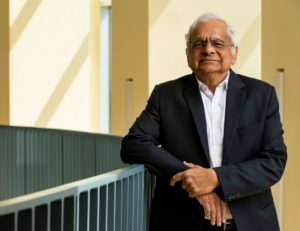Texas A&M quantum physics professor named Townes Medal winner
Theoretical work pushes technology in optics, biophotonics
Girish Agarwal, Ph.D., professor in the Department of Biological and Agricultural Engineering at Texas A&M University, has been selected by Optica members as the 2022 recipient of the Charles Hard Townes Medal.

Optica, founded in 1916, is a leading society in optics and photonics.
Agarwal will receive the Charles Hard Townes Medal at Optica’s annual conference in October.
“I am honored and humbled to receive this award,” he said. “It is a matter of great pride for me to be named a Charles Townes Medal recipient.”
Contributions worthy of a Townes Medal
The medal honors Charles Hard Townes, whose pioneering contributions to lasers and masers led to the development of the field of quantum electronics and won him the Nobel Prize in Physics in 1964. Charles Townes’s students and colleagues as well as Bell Laboratories, Hewlett-Packard and The Perkin Fund endowed the Townes Medal.
Agarwal is being honored for discoveries in theoretical quantum optics, especially vacuum induced coherences, photon added coherent states, non-classical cat states for qubits via engineered many body interactions, and transparency in optomechanical systems. This theoretical work has translated into advances in microscopy and quantum spectroscopy, which are allowing scientists to look deeper into the fundamentals of matter and energy.
His work in quantum physics has been supported by the National Science Foundation, the Air Force Office of Scientific Research and the Welch Foundation. Within the Department of Biological and Agricultural Engineering, Agarwal has been focusing on biophotonics and imaging and sensing tools related to the field.
Using physics techniques for biology-related problems
Biophotonics is the study of optical processes in naturally occurring biological systems and in bioengineered materials. Using quantum spectroscopy and laser technology, scientists in the Texas A&M Center for Biophotonics can probe the vibrational states of molecules to generate specific spectral signatures that can be used to rapidly and reliably assess plant composition, the presence of food-borne pathogens, the presence of pests in crop fields and more, according to the center.
“We are applying physics-related techniques to address biologically related problems,” Agarwal said. “We are working on application of quantum tools that will provide better sensing and emitting capabilities that can address a wide range of applications. The idea is to reach scales that were impossible to reach.”
How can a cat be both dead and alive?
In the 1930s, physicist Erwin Schrödinger, one of the developers of quantum mechanics, discovered that quantum mechanics hypothetically allows a cat to be simultaneously dead and alive, an idea completely contrary to everyday experience. This led to extensive discussions among the founding fathers of quantum mechanics, especially Albert Einstein.
This strange property remained a paradox for many decades until the 1990s, when Nobel laureates David Wineland and Serge Haroche started realizing such paradoxical states, albeit with systems much smaller than a cat. In 1997, Agarwal proposed how to experimentally prepare “Schrodinger cat” states for objects. Such states are now extensively used by the quantum computing community.
Agarwal’s ideas were successfully implemented in a paper published in Science in 2019.
How can light be both a wave and a particle?
After the development of quantum mechanics in the 1920s, experiments on light still relied on the theory that light behaved like waves. Neils Bohr, a prominent physicist, introduced the idea of wave particle duality. The theory posited that for some experiments, light behaves like a wave while for others, it behaves like a particle.
The wave-particle duality of light led to great debate among the founding fathers of quantum mechanics. In the 1990s, physicists started attempting to quantify the concept. Agarwal’s recent theoretical work in focused on a complete quantitative formulation of the wave particle duality.
The theoretical ideas were confirmed in the paper published in Science Advances. Physics World ranked the discovery among finalists for the “breakthrough discoveries of 2021.”
How to understand the border between classical and quantum physics?
In 1963, few years after the first working laser was introduced, Nobel Laureate Roy Glauber introduced how the radiation from laser could be characterized in terms of its physical properties, and he introduced the very popular concept of coherent states. Agarwal discovered photon added coherent states in 1991. These new states enable one to understand the border between classical and quantum descriptions. Such states were realized by experimentalists in 2004.
Agarwal’s current focus is on using the tools of quantum mechanics for developing better sensing, imaging, spectroscopy and microscopy capabilities with applications in bioimaging. In collaboration with Vladislav Yakovlev, Ph.D., professor in the Department of Biomedical Engineering in the College of Engineering, he has been looking at the imaging of cancer cells using quantum tools.
“These advancements take time. Presenting a theory and having it confirmed and widely recognized sometimes takes decades,” Agarwal said. “Being a part of breakthroughs in the field has been the goal throughout my career.”
30-


